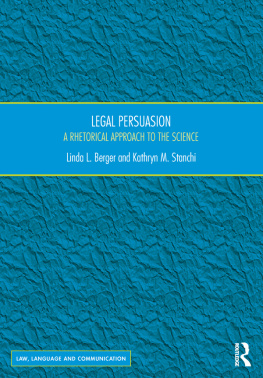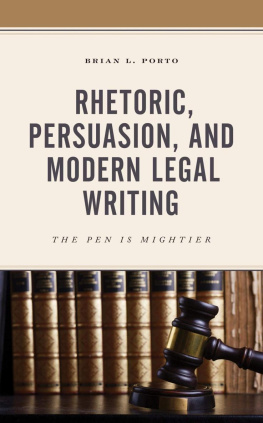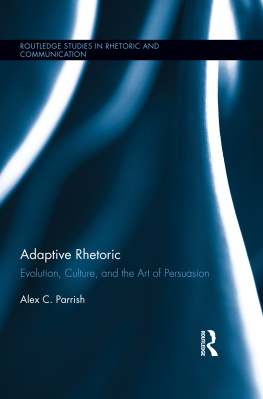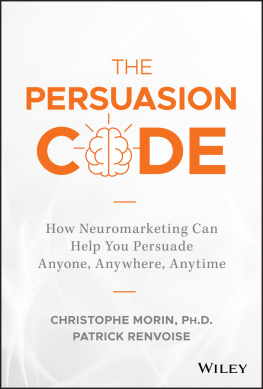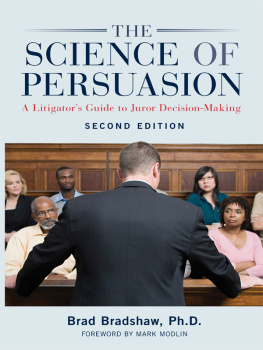First published 2018
by Routledge
2 Park Square, Milton Park, Abingdon, Oxon OX14 4RN
and by Routledge
711 Third Avenue, New York, NY 10017
Routledge is an imprint of the Taylor & Francis Group, an informa business
2018 Linda L. Berger and Kathryn M. Stanchi
The right of Linda L. Berger and Kathryn M. Stanchi to be identified as authors of this work has been asserted by them in accordance with sections 77 and 78 of the Copyright, Designs and Patents Act 1988.
All rights reserved. No part of this book may be reprinted or reproduced or utilised in any form or by any electronic, mechanical, or other means, now known or hereafter invented, including photocopying and recording, or in any information storage or retrieval system, without permission in writing from the publishers.
Trademark notice: Product or corporate names may be trademarks or registered trademarks, and are used only for identification and explanation without intent to infringe.
British Library Cataloguing- in- Publication Data
A catalogue record for this book is available from the British Library
Library of Congress Cataloging- in- Publication Data
Names: Berger, Linda L., author. | Stanchi, Kathryn M., author.
Title: Legal persuasion : a rhetorical approach to the science /
Linda L. Berger, Kathryn M. Stanchi.
Description: Abingdon, Oxon [UK] ; New York : Routledge, 2017. |
Series: Law, language and communication | Includes bibliographical
references and index.
Identifiers: LCCN 2017009322| ISBN 9781472464521 (hardback) |
ISBN 9781472464552 (pbk.)
Subjects: LCSH: Communication in law. | Semiotics (Law) |
Forensic oratory. | Persuasion (Rhetoric) | LawMethodology. |
LawLanguage.
Classification: LCC K213 .B43 2017 | DDC 340/.14dc23
LC record available at https://lccn.loc.gov/2017009322
ISBN: 978-1-4724-6452-1 (hbk)
ISBN: 978-1-4724-6455-2 (pbk)
ISBN: 978-1-315-11299-2 (ebk)
Typeset in Galliard
by Apex CoVantage, LLC
Infinity icon LovArt/Shutterstock

When we got together to write this book, we had in mind an overview of legal persuasion that combined our different areas of expertise. Kathy Stanchi has been writing for years about the insights persuasion science provides for the thoughtful and deliberate legal advocate. Linda Berger has been examining classical and contemporary rhetorical theories and using rhetorical methods and rhetorical criticism to analyze lawyers arguments, especially in written briefs and opinions. When we decided to write together, we realized that although we had approached the subject of legal persuasion from different directions, we had arrived at the same place: legal persuasion results from making and breaking mental connections. We thought that a book exploring the rich interdisciplinary potential of rhetoric and science would be a novel and useful approach to persuasion and would have much to offer the practice and study of law.
In that sense, this book is a true collaboration. While we each took primary responsibility for certain chapters that were within our specific areas of expertise, we both made our marks on every part of this book. Both of us were pleasantly surprised at the true synergy that our collaboration created when we considered and edited the chapters outside our usual areas of expertise. We believe that synergy makes the book a real integration of rhetorical theory and science. Thus, the order of authors reflects the alphabetical order of the letters of our last name. For better or worse, every part of this book is truly both of ours.
Our initial approach was to chart a middle course that included a strong foundation in the theory of persuasion but also a true grounding in the practical. The books organization reflects this approach in that each chapter takes the time to explain and describe the theory and also includes case studies as examples of the theory as applied. As legal writing professors, we know that a firm grounding in theory is essential to the ability to make advocacy decisions in the wide diversity of contexts that confront the legal advocate. As much as practicing lawyers like to disclaim theory, they use it every day. As just one example, virtually every litigator will tell you that they start their case planning with a theory of the case that is meant to guide their strategic decision making throughout the litigation. Persuasion theory works similarly; it is an overarching set of principles that lawyers can translate into practical strategic decisions. This book is meant to help with that translation, both by bringing together in one source some of the leading persuasion theories and by showing how those theories have been used by legal advocates in past cases.
Our idea to combine theory with practice, however, presented the problem of audience. Who is the intended audience of the book? Practicing lawyers? Law professors? Students? We thought that those groups, and members of the public in general, would be interested in how persuasion works in legal settings. As we wrote, we recognized that we were writing to all these different audiences. That broad target for the book presented some tone and communication issues speaking simultaneously to law professors, practicing lawyers, and students was often a tightrope walk for us. We very much did not want to dumb down the theory, but we did want it to be understandable to everyone in our audience. We often erred on the side of simplifying, but sometimes we included complex theoretical details because of a desire for thoroughness or accuracy. We recognize that in attempting to walk this tightrope of audience, we might have occasionally missed the mark.
But if nothing else, the premise of this book is that lawyers should be thinking about theory, and theoreticians should be thinking about the practical, and everybody should be thinking about how to educate the next generation. We believed that the hiccups resulting from our wish to follow this integrated approach were worth it to break new interdisciplinary ground for legal advocacy. We hope the result is challenging, useful, informative, and interesting.
16
Syllogistic and Analogical Case Arguments
To construct an effective syllogism, the advocate first creates the appropriate categories and frames the relevant questions. Here, appropriate and relevant mean the categories and questions that appear logically to lead to the advocates preferred outcome. The syllogistic framework can be used for the more straightforward application of rules (major premises) to facts (minor premises) and the more complex process in which arguments are built both on the rules themselves and on comparisons with precedent cases from which the rules emerge.
As we have discussed throughout the book, schematic cognition, or categorical thinking, is a mainstay of decision making. For example, one subject in a psychological study of syllogistic reasoning reported that when he read the premise all the artists are bee-keepers, he pictured in his mind a group of artists in [a] room and imagined they all had beekeepers hats on. (Johnson-Laird and Steedman 1978). This not only gives us information about one way in which we process syllogistic reasoning (through images), but also about how one kind of syllogistic fallacy can occur. In the hypothetical, all the artists are beekeepers but not all the beekeepers are artists. But if we process the categorical statement all the artists are beekeepers by imagining a room containing people who are wearing both berets (artists) and beekeepers hats (beekeepers), it is easy to flip the premise. In our imagined room, it looks like all the beekeepers are also artists, which is not true. Our way of imagining the premise (visualizing a room of people) can lead easily to this fallacy. Thats our System 1 thinking at work, and it is the same category error people make when they see primarily African-American men arrested on the nightly news and conclude that all or most African-American men are criminals.

